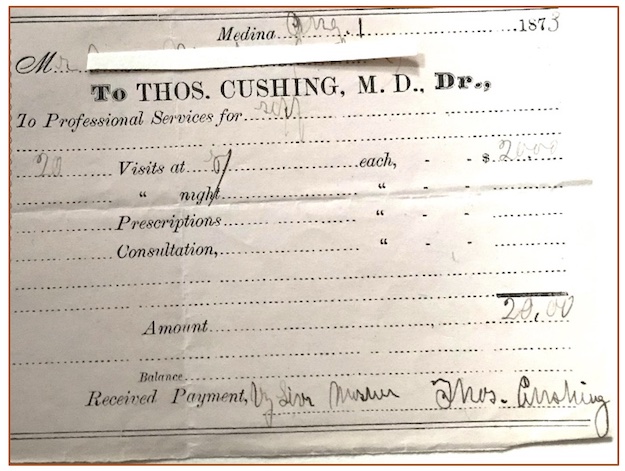Church cookbook from 1901 included many home remedies for health afflictions

A receipt from 1873, Dr. Thomas Cushing then working in Medina, acknowledges payment of $20 for 20 home visits.
By Catherine Cooper, Orleans County Historian
“Illuminating Orleans” – Volume 4, No. 13
If you were a farm laborer living in Shelby in 1873 and you broke your leg or your youngest daughter was seriously ill, what would you do?
Then, as now, the cost of medical care was a matter of concern. Dr. Cushing’s fee list from 1873 illustrates the cost of his services. A visit to your Shelby home would cost $1, with mileage added. As a farm laborer, you would earn $1.25 per day, according to the History of Wages in the United States from Colonial Times to 1928.
Dr. Cushing could have set your broken bone, but even he had few weapons to fight your daughter’s dysentery. It is not surprising that home medical remedies developed. It is unlikely that they would have effectively treated cholera or dysentery, but the cough medicines and liniments would most likely have been effective.
All too often, these remedies survive as handwritten notes on fading scraps of paper. Fortunately, the Crescent Circle cookbook compiled by members of the Methodist Episcopal Church in East Shelby included a collection of home remedies. A reprint of this 1901 cookbook was included in the West Jackson Corners Cookbook published by the East Shelby Community Bible Church in 2004.

Dr. Cushing’s fee list, 1873
The instructions provided for the preparation of these remedies are very basic. Some of the ingredients and terms used may be unfamiliar, explanations are provided.
Cholera Cure (1)
*Tincture of opium, tincture of rhubarb, tincture of cayenne. Mix well together.
Dose: 15 to 30 drops in water, to be repeated in 15 or 20 minutes if necessary.
Mrs. John Brown
(*Tincture – the berries, leaves, roots or bark of a plant dissolved in alcohol or vinegar)
Cholera Cure (2)
One oz. rhubarb, 1 oz. camphor, 1 oz. laudanum*. Dose for children 5 drops, for adults 15 drops repeated once in 2 hours.
(*Laudanum – also known as opium, made from air-dried poppies could be purchased without the need of a prescription until 1915.)
Cough Medicine
Juice of 3 lemons, 1 cup loaf sugar*, 2 or 3 tablespoons castor oil.
Mrs. Ernest Hill
(* Loaf sugar or sugarloaf – refined sugar was sold in loaf form until the late 19th century.)
Croup
A teaspoon alum*, grated, 2 teaspoons granulated sugar. Give as quick as possible, keep giving until vomiting is produced.
Mrs. R. Neal
(*Alum is a mineral salt)
Diphtheria
One gallon strong apple vinegar, 1 tablespoon saltpeter*, 1 teaspoon cayenne pepper, 1 piece borax size of a chestnut. Gargle every half hour.
A.L. Thurston
(*Saltpeter or potassium nitrate was mined in Kentucky as also used to make gunpowder)
Dysentery Medicine
Tincture of opium, camphor, and rhubarb in equal parts. Dose 10-15 drops.
Mrs. E.I. Hill
Kittredge Grease
One half-pound fresh butter, 1 oz. orgamin (sic) oil, 1 ounce camphor gum. Simmer all together. Grease well with it. Give ½ teaspoon every little while.
Mrs. Mary Kilner
Linament
One egg, 1 oz. turpentine, 1 oz. of camphor, ½ pint of vinegar. Shake egg and vinegar, then add the rest and shake for 10 minutes.
Mrs. Lucy Crane
Blood Remedy for Stomach, Liver, Kidneys
Bayberry leaves 2 oz., Senna leaves 2 oz., buchue*(sic) leaves 1 oz., *may-apple blossoms 1 oz., bittersweet root 2 oz., wild cherry bark 1. oz., angelica root 2 oz., culvers root 3 oz.
Directions: Put the above in 3 quarts boiling water. Boil down to two quarts and 1 pint, then strain through a piece of cheese cloth and add 1 pint of alcohol to keep from souring. Bottle and use.
Dose: One tablespoon 3 times a day before the meals ½ hour. For children from 1 to 12 years, 1 teaspoon 2 times a day.
Dr. Herman
(*Senna – a medicinal herb used as a laxative, buchu – a medicinal herb from South Africa used for kidney and urinary tract problems, the mayapple plant is a woodland rambler, it’s roots, leaves and seeds are poisonous, it was used as a purgative, Culver’s root is a wildflower, used as an emetic and analgesic.)
We have not been able to identify the Dr. Herman who provided this “Blood Remedy for Stomach, Liver and Kidneys,” but with its combination of laxative, purgative and emetic agents, it no doubt, produced memorable results.
(Please note: These remedies are presented solely for their historical interest; they are not intended as prescriptions for use.)









































































